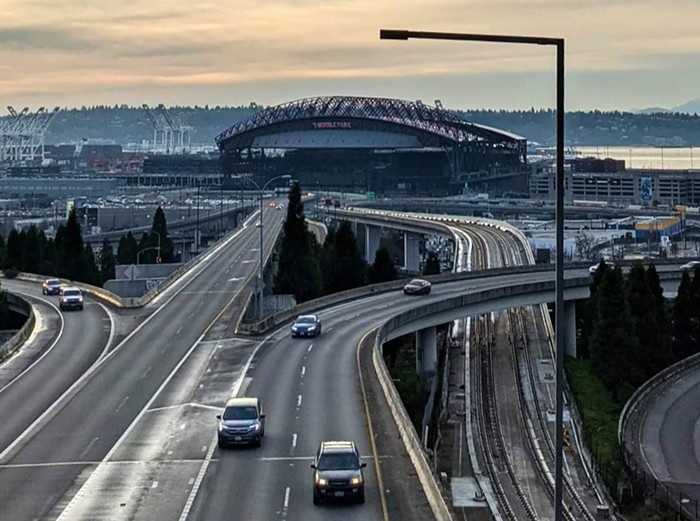When Greg Kucera casually walks in and asks how I'm doing, my hand just goes up to my heart. That's when he says, "Even people who don't know can feel it." We're standing in the corner of the back room of his gallery just before First Thursday starts. We're inside a modestly sized show by Seattle artist Mark Calderon. In the wall next to us, there is a small cavity shaped like a cloud. Another wall has three more cavities. Two are shaped, vaguely, like leaves. Between them is a hollow, shadowy baby. The baby's feet are crossed. Another pair of crossing feet, lifelike and cast in lead, lie on a pedestal. Near them, a small lead turtle on its back tries to right itself, craning its neck so the soft throat is exposed, twisting a tiny leg to push.
"It" is not a secret. Calderon is married to Chiyo Ishikawa, longtime Seattle Art Museum curator. Her son Nap had a bike accident on Pike and Boren on May 29, 2012. Days later, he died, just before what would have been his 19th birthday. Nap's father is Dick Cantwell, owner of Elysian Brewing. On the night of this opening, exactly a year later, Kucera is preparing to receive a gathering at the gallery of heavy-hearted art-world figures, brewers, and teenage skateboarders.
The absent baby, the cloud, the turtle, the feet that might be sticking out from under sheets—Nap's shocking absence can be felt in all of them. But it would be a mistake to characterize the exhibition, Nothing Is as Eloquent as Nothing, as just a memorial for a single soul. Again, you feel it whether you know or not. Calderon's own statement about the show refers generally to "personal losses," in addition to other specific and universal sorrows, some readily recognizable.
For instance, two sculptures instantly raise the haunting specter of another downed teenager, Trayvon Martin. They're black hoodies, constructed using the stiff black tape that's used to repair the spines of books when they've split apart. They hang on the wall, each like an empty shell, head lowered. The metaphor of a broken spine and a broken life and a broken story is implicit. One hoodie has extra-long arms joined into a continuous loop pooling on the floor, like a holy robe or a hijab.
Nothing Is as Eloquent as Nothing is the most cohesive, powerful, and memorable Calderon exhibition I've ever seen, but it is by no means a departure. He continues to synthesize Japanese Buddhist, Chicano, Catholic, classical Greek, and yoga forms by using human and animal figures. At least one reverberation from the past is made explicit: Kucera has mounted a sculpture Calderon made in 2001 like a beacon high above the desk in his office just off the gallery. This older sculpture is a ruddy bronze baby, plump and hearty, feet crossed, face pushed rudely toward the wall—the same outline as the new, hollow baby that looks so glassy in its emptiness and shadows. They are siblings. Calderon made the new baby, Lacuna 3 (baby), in cast acrylic modified cement that he embedded into an area of wall he cut out over a period of three days when Kucera gave Calderon the keys and let him chop up his gallery. Lacuna 2 and 4 are the leaf-like shapes on either side of the baby, each lined with a bit of hidden color (neon pink, neon green) so that the cavities appear to glow lightly and from a hidden source, like the nondenominational sacred installations of Quaker artist James Turrell. Calderon is summoning many spirits at once; they protect each other. One appears in the form of a cast bronze outline of Lake Washington, recognizable but different, taken from a map prior to the creation of the city of Seattle. It sits on the floor, where water has been poured into it to create a dark ghost lake with a reflective surface as smooth as shiny, cold metal.
There are two pieces in the show that are somewhat different from the rest, but again, they connect. One is a small bronze man in a full forward bend, his penis extending into his mouth. The title is Ouroboros, after the Egyptian snake god who eats his own tail. He's self-continuing and self-contained, like the black hoodie with its one long arm, free from beginnings and ends. But he also is entirely closed in, blocked off, choking on himself. I can't tell whether Calderon would fear or hope to be this creature; I'd say both.
No other artist has shown with Kucera longer than Calderon; this is the artist's eighth solo show at the gallery since 1985. The last one was a whole decade ago, with a 2007 exhibition in Bellevue in between. Kucera says this is the first time Calderon has chosen to work with someone else, a friend who took a portrait that Calderon himself set up. In the photograph, Calderon is standing in what looks like his studio, relaxed, with his arms at his sides. In one of his hands, he's holding something fleshy and limb-like—it turns out to be beef tongue, according to the title, Lengua—branded with the word "FAITH." The artist is wearing spattered work pants and a slightly hardened expression. He is not brandishing faith, just holding on to it. ![]()


















